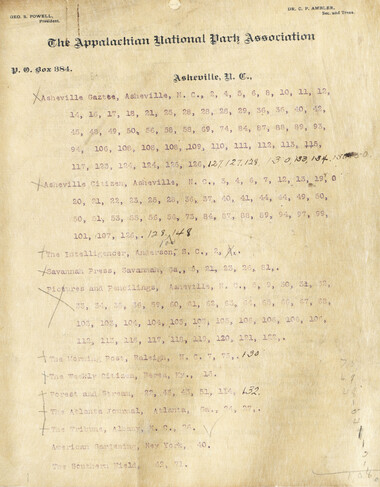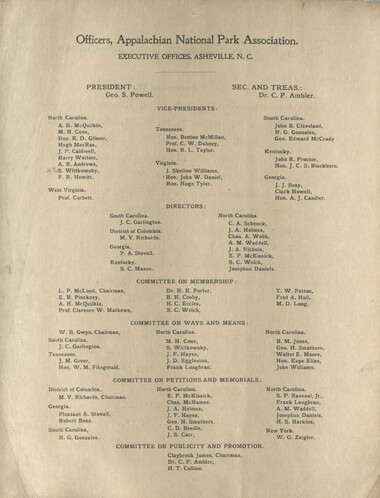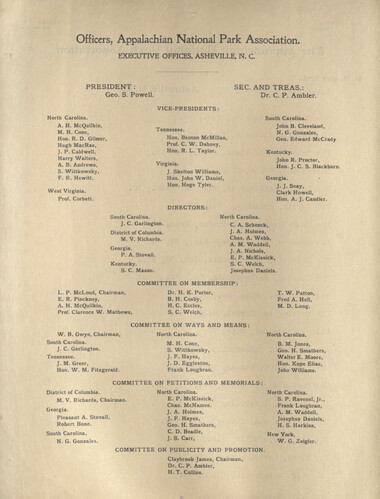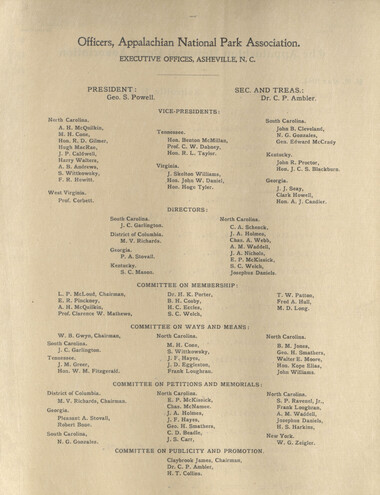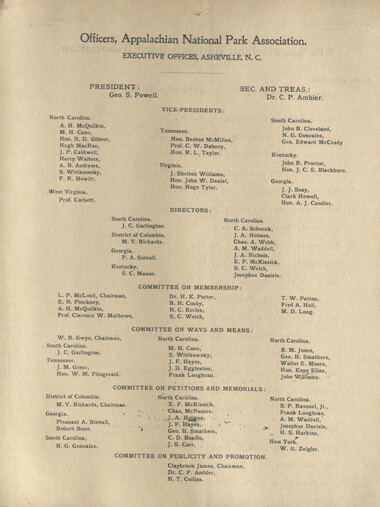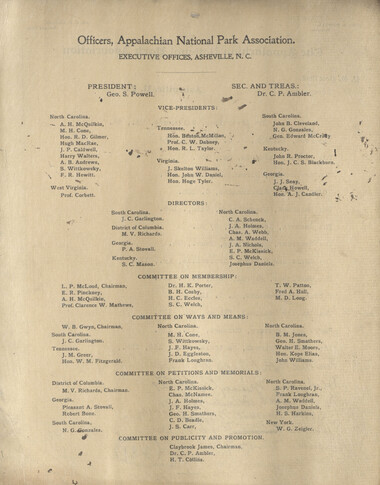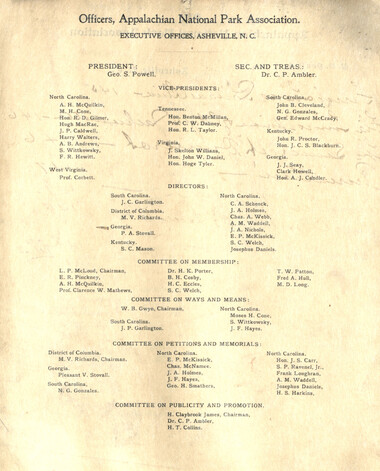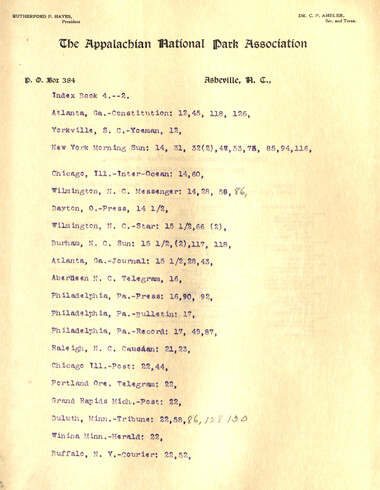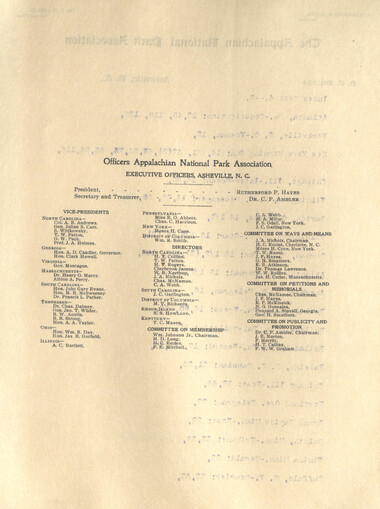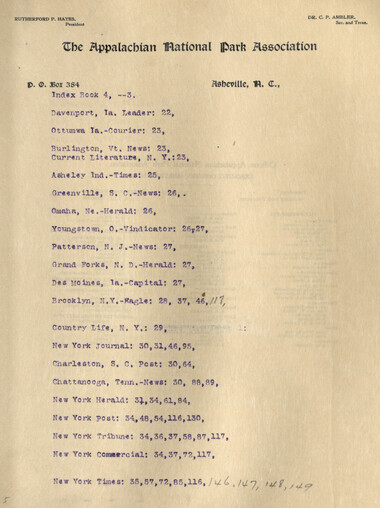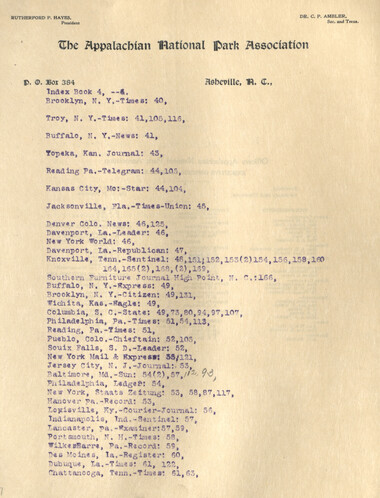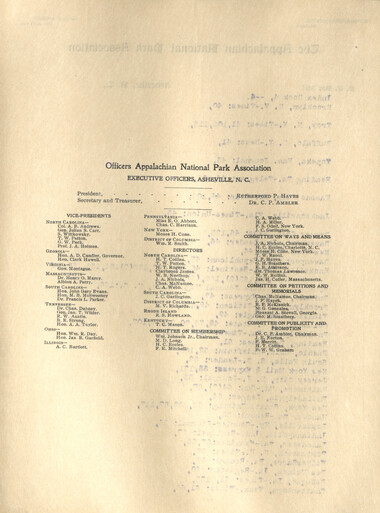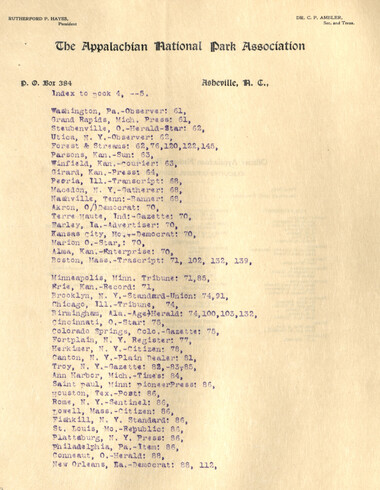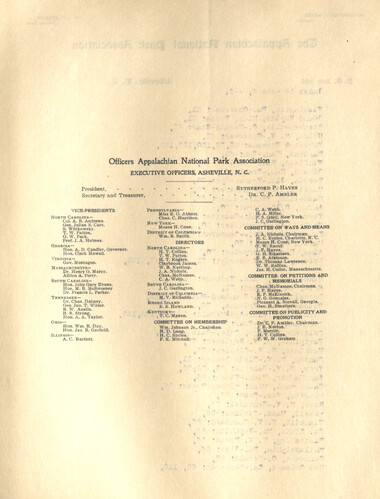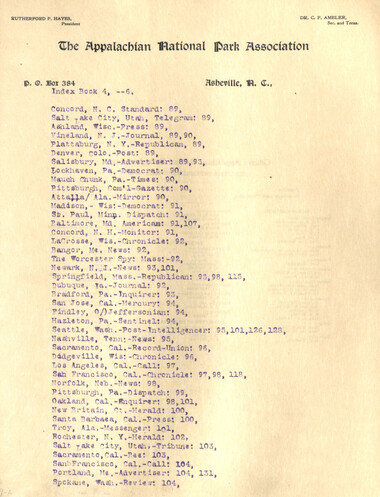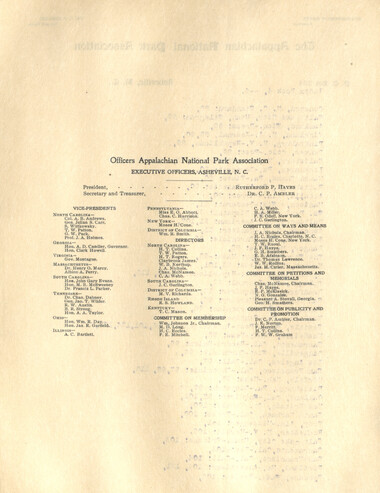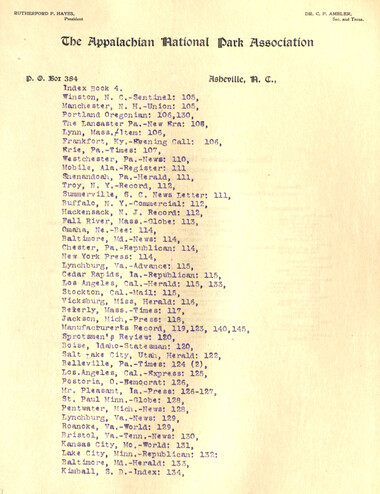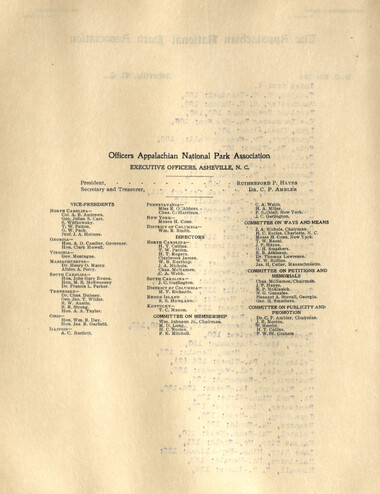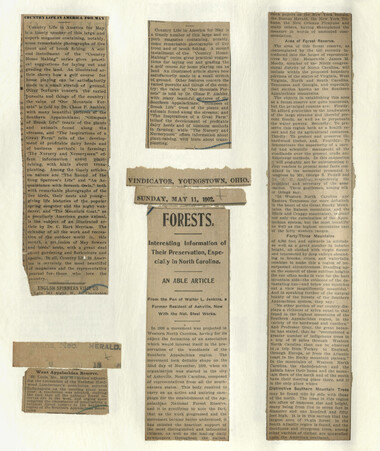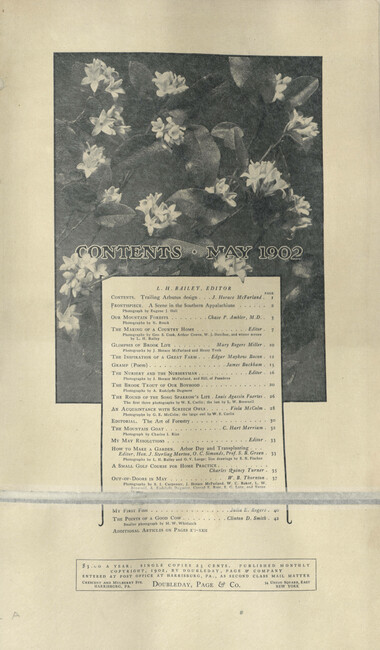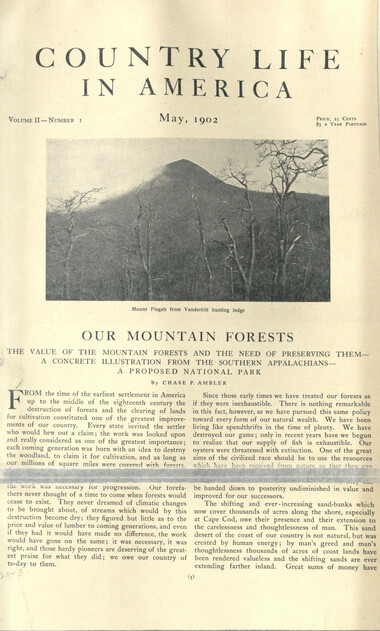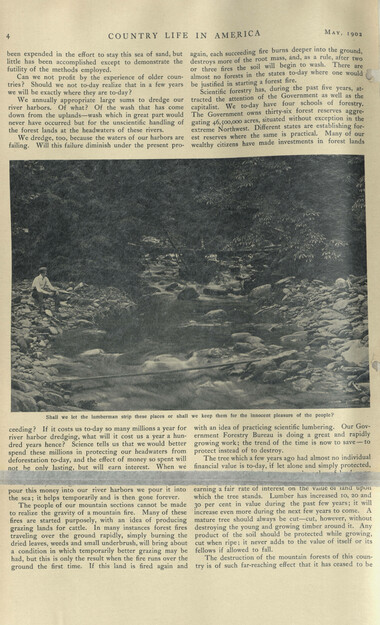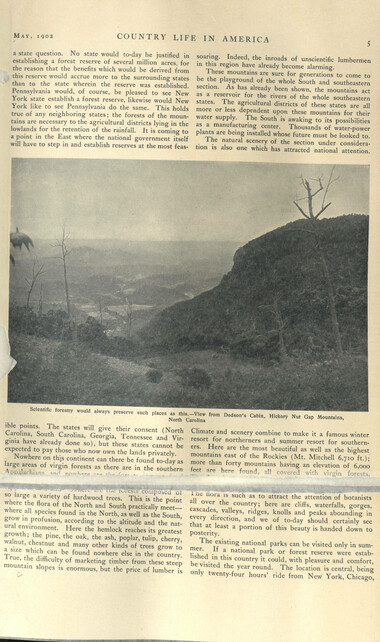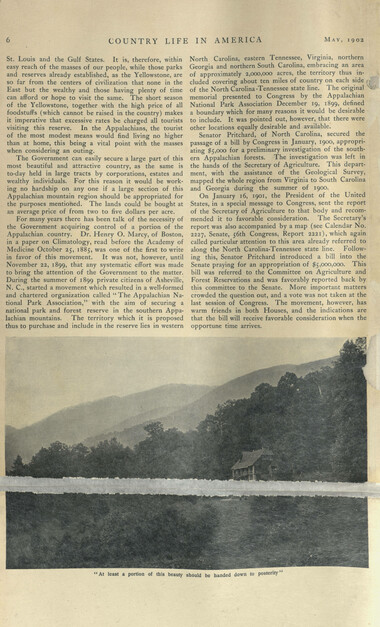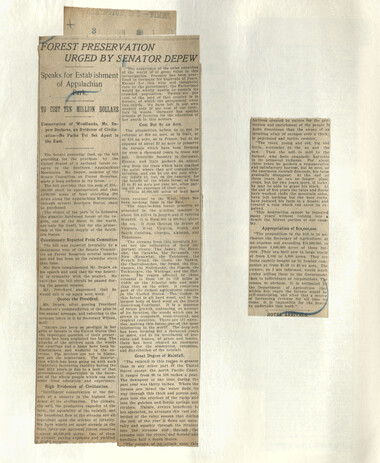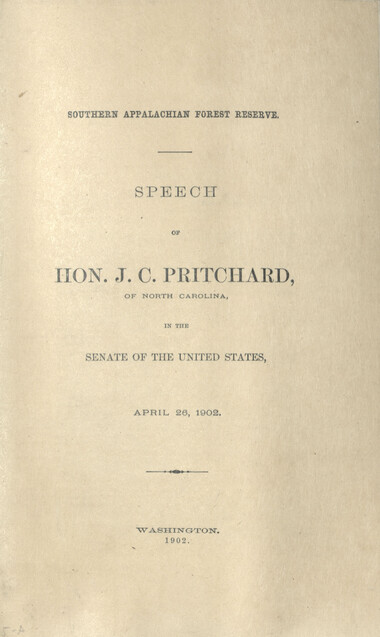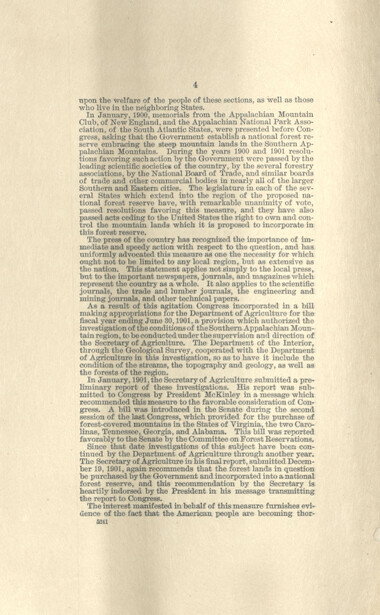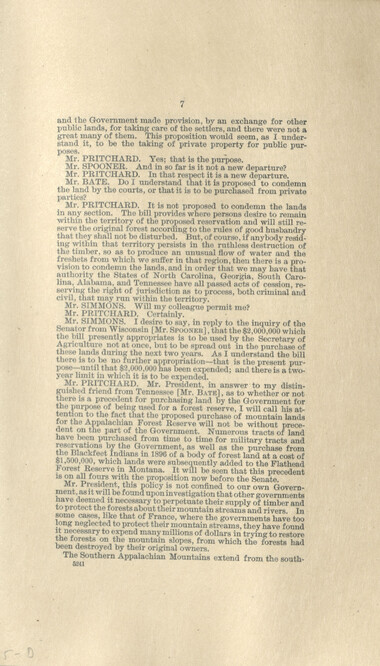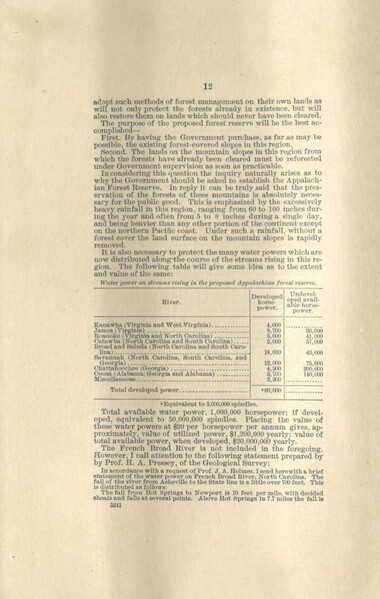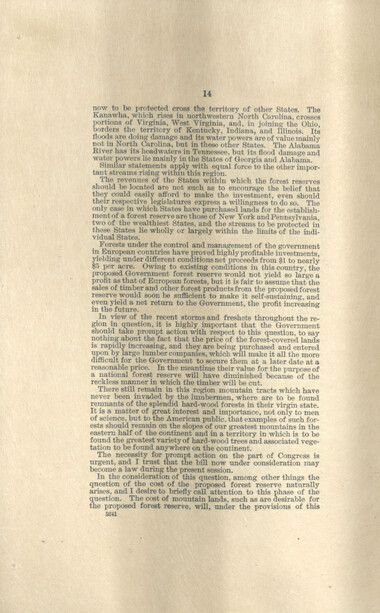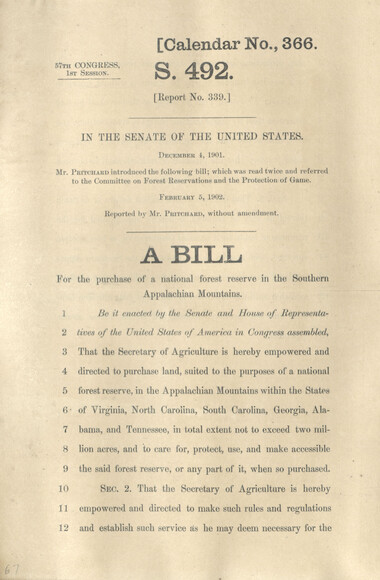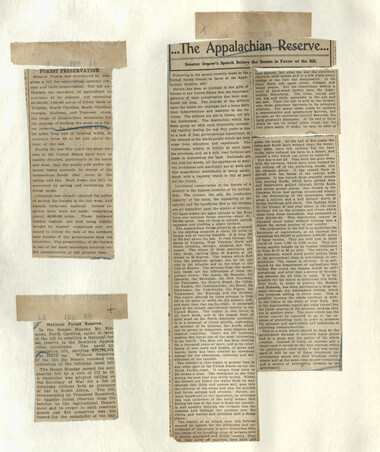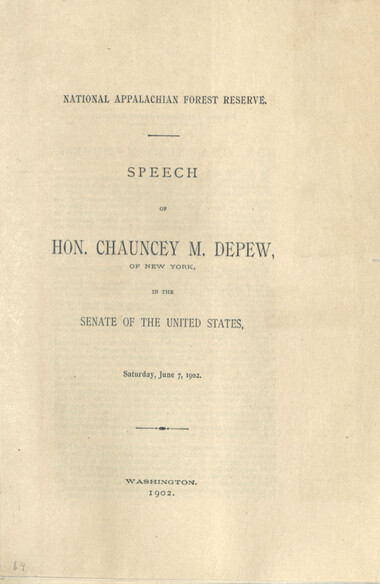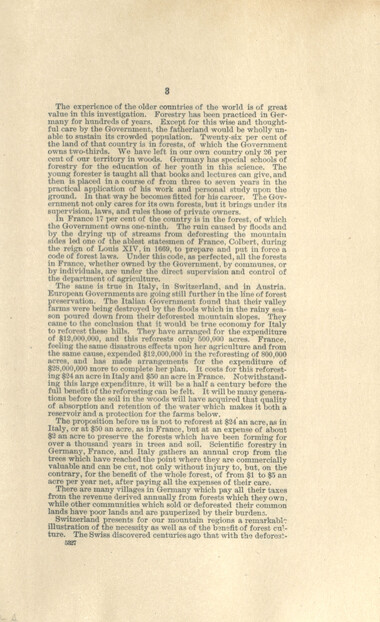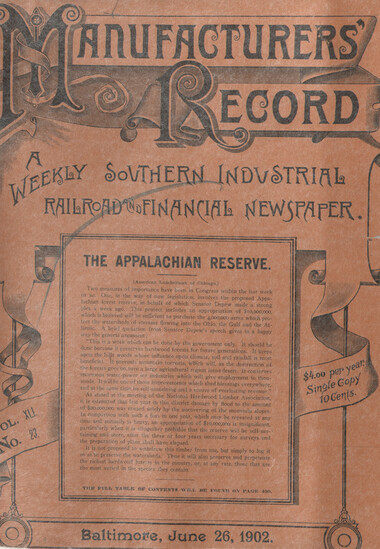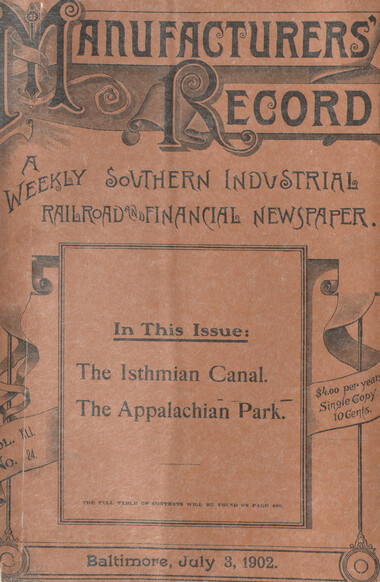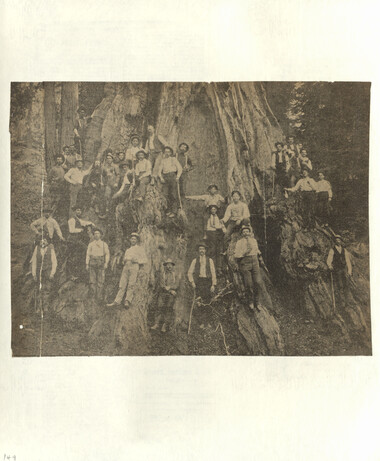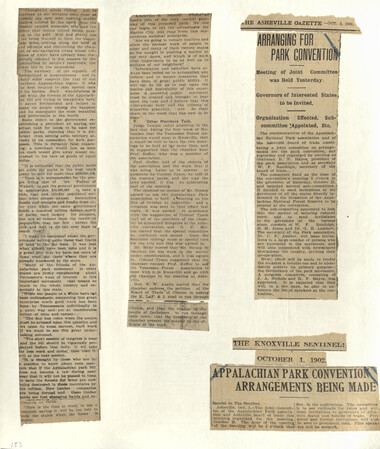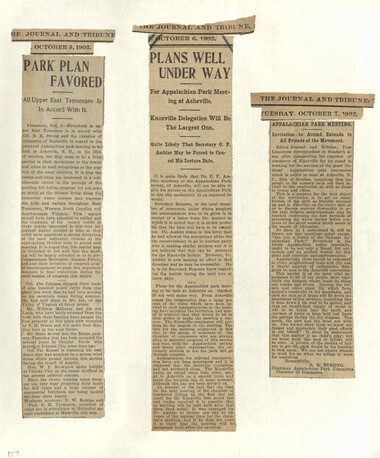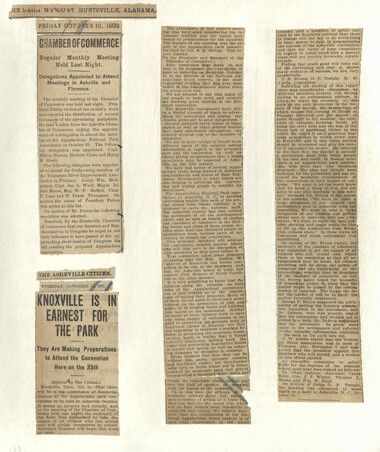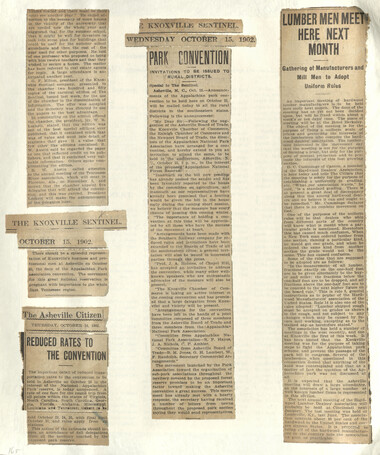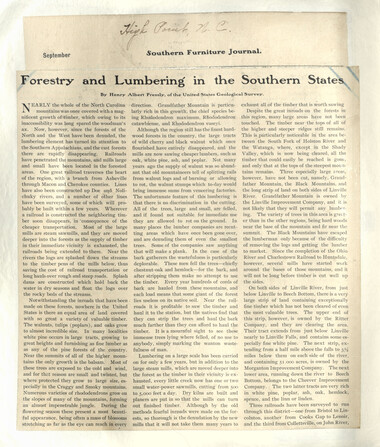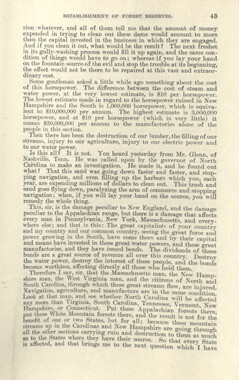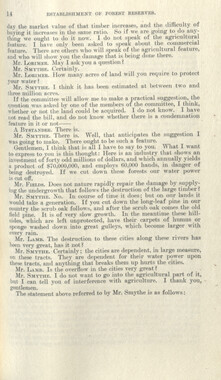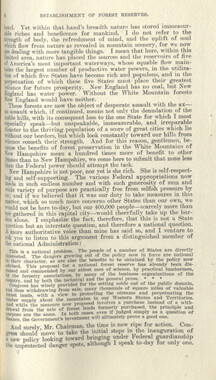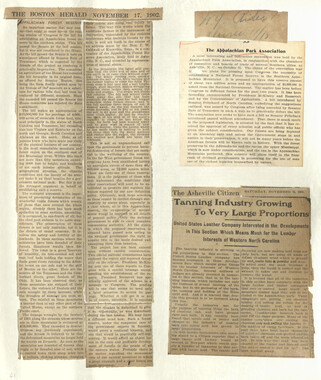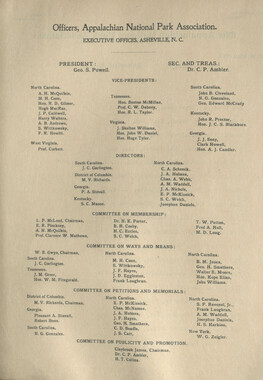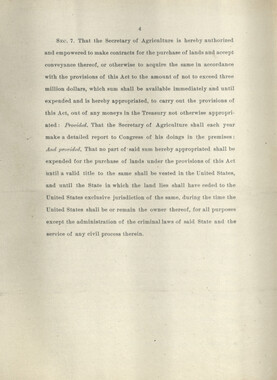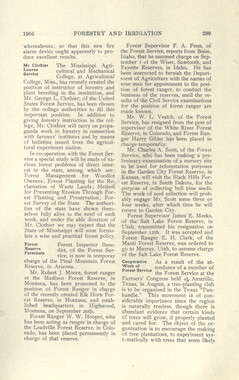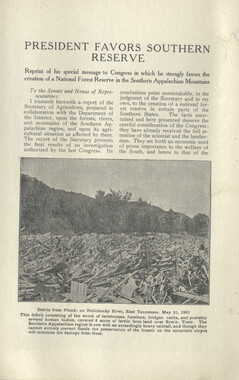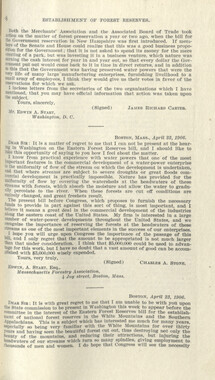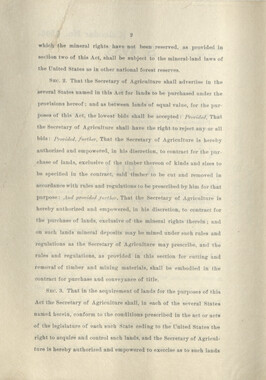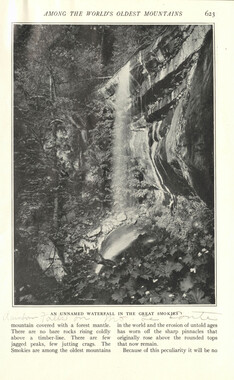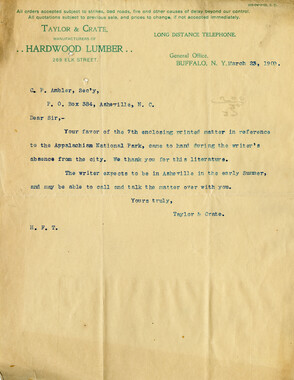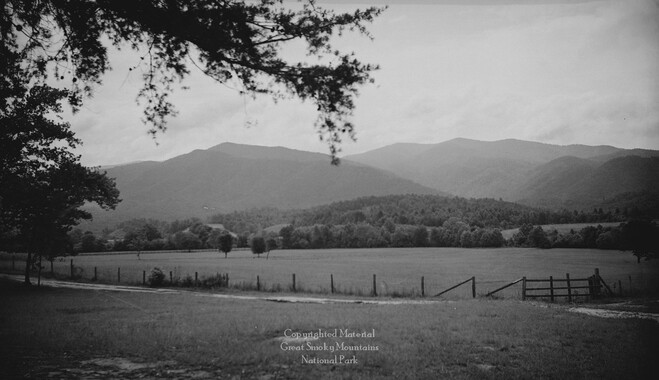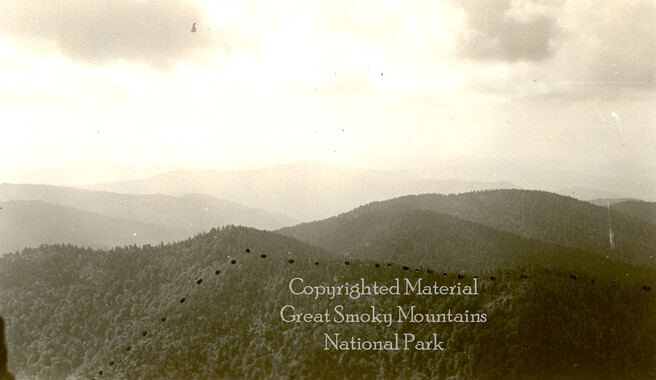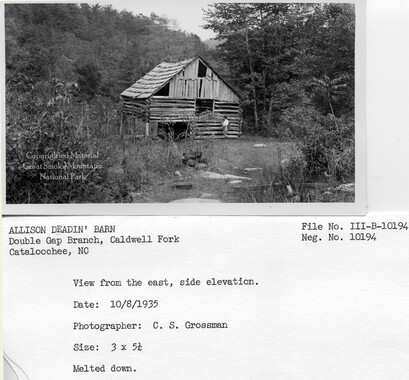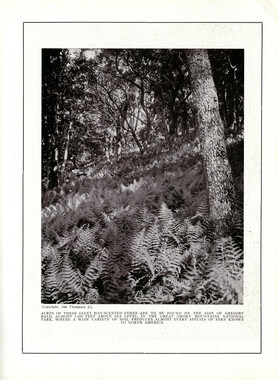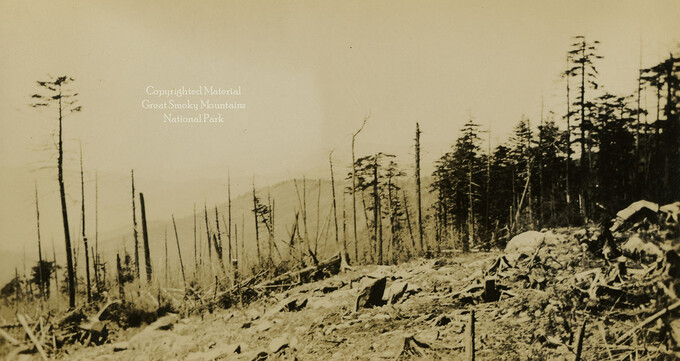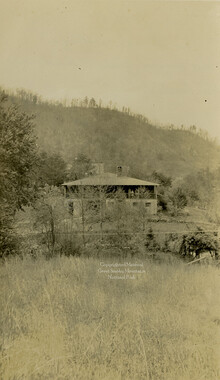Western Carolina University (20)
View all
- Canton Champion Fibre Company (2308)
- Cherokee Traditions (291)
- Civil War in Southern Appalachia (165)
- Craft Revival (1942)
- Great Smoky Mountains - A Park for America (2857)
- Highlights from Western Carolina University (430)
- Horace Kephart (941)
- Journeys Through Jackson (159)
- LGBTQIA+ Archive of Jackson County (85)
- Oral Histories of Western North Carolina (314)
- Picturing Appalachia (6772)
- Stories of Mountain Folk (413)
- Travel Western North Carolina (160)
- Western Carolina University Fine Art Museum Vitreograph Collection (129)
- Western Carolina University Herbarium (92)
- Western Carolina University: Making Memories (708)
- Western Carolina University Publications (2353)
- Western Carolina University Restricted Electronic Theses and Dissertations (146)
- Western North Carolina Regional Maps (71)
- World War II in Southern Appalachia (131)
University of North Carolina Asheville (6)
View all
- Allanstand Cottage Industries (62)
- Appalachian National Park Association (53)
- Bennett, Kelly, 1890-1974 (1388)
- Berry, Walter (76)
- Brasstown Carvers (40)
- Carver, George Washington, 1864?-1943 (26)
- Cathey, Joseph, 1803-1874 (1)
- Champion Fibre Company (233)
- Champion Paper and Fibre Company (297)
- Cherokee Indian Fair Association (16)
- Cherokee Language Program (22)
- Crowe, Amanda (40)
- Edmonston, Thomas Benton, 1842-1907 (7)
- Ensley, A. L. (Abraham Lincoln), 1865-1948 (275)
- Fromer, Irving Rhodes, 1913-1994 (70)
- George Butz (BFS 1907) (46)
- Goodrich, Frances Louisa (120)
- Grant, George Alexander, 1891-1964 (96)
- Heard, Marian Gladys (60)
- Kephart, Calvin, 1883-1969 (15)
- Kephart, Horace, 1862-1931 (313)
- Kephart, Laura, 1862-1954 (39)
- Laney, Gideon Thomas, 1889-1976 (439)
- Masa, George, 1881-1933 (61)
- McElhinney, William Julian, 1896-1953 (44)
- Niggli, Josephina, 1910-1983 (10)
- North Carolina Park Commission (105)
- Osborne, Kezia Stradley (9)
- Owens, Samuel Robert, 1918-1995 (11)
- Penland Weavers and Potters (36)
- Roberts, Vivienne (15)
- Roth, Albert, 1890-1974 (142)
- Schenck, Carl Alwin, 1868-1955 (1)
- Sherrill's Photography Studio (2565)
- Southern Highland Handicraft Guild (127)
- Southern Highlanders, Inc. (71)
- Stalcup, Jesse Bryson (46)
- Stearns, I. K. (213)
- Thompson, James Edward, 1880-1976 (226)
- United States. Indian Arts and Crafts Board (130)
- USFS (683)
- Vance, Zebulon Baird, 1830-1894 (1)
- Weaver, Zebulon, 1872-1948 (58)
- Western Carolina College (230)
- Western Carolina Teachers College (282)
- Western Carolina University (1840)
- Western Carolina University. Mountain Heritage Center (18)
- Whitman, Walt, 1819-1892 (10)
- Wilburn, Hiram Coleman, 1880-1967 (73)
- Williams, Isadora (3)
- Cain, Doreyl Ammons (0)
- Crittenden, Lorraine (0)
- Rhodes, Judy (0)
- Smith, Edward Clark (0)
- Appalachian Region, Southern (2569)
- Asheville (N.C.) (1923)
- Avery County (N.C.) (26)
- Blount County (Tenn.) (169)
- Buncombe County (N.C.) (1672)
- Cherokee County (N.C.) (283)
- Clay County (N.C.) (555)
- Graham County (N.C.) (233)
- Great Smoky Mountains National Park (N.C. and Tenn.) (519)
- Haywood County (N.C.) (3567)
- Henderson County (N.C.) (70)
- Jackson County (N.C.) (4745)
- Knox County (Tenn.) (31)
- Knoxville (Tenn.) (12)
- Lake Santeetlah (N.C.) (10)
- Macon County (N.C.) (420)
- Madison County (N.C.) (215)
- McDowell County (N.C.) (39)
- Mitchell County (N.C.) (132)
- Polk County (N.C.) (35)
- Qualla Boundary (981)
- Rutherford County (N.C.) (76)
- Swain County (N.C.) (2117)
- Transylvania County (N.C.) (270)
- Watauga County (N.C.) (12)
- Waynesville (N.C.) (84)
- Yancey County (N.C.) (72)
- Aerial Photographs (3)
- Aerial Views (60)
- Albums (books) (4)
- Articles (1)
- Artifacts (object Genre) (228)
- Bibliographies (1)
- Biography (general Genre) (2)
- Cards (information Artifacts) (38)
- Clippings (information Artifacts) (191)
- Copybooks (instructional Materials) (3)
- Crafts (art Genres) (622)
- Depictions (visual Works) (21)
- Design Drawings (1)
- Drawings (visual Works) (185)
- Envelopes (73)
- Exhibitions (events) (1)
- Facsimiles (reproductions) (1)
- Fiction (general Genre) (4)
- Financial Records (12)
- Fliers (printed Matter) (67)
- Glass Plate Negatives (381)
- Guidebooks (2)
- Internegatives (10)
- Interviews (815)
- Land Surveys (102)
- Letters (correspondence) (1013)
- Manuscripts (documents) (618)
- Maps (documents) (177)
- Memorandums (25)
- Minutes (administrative Records) (59)
- Negatives (photographs) (5926)
- Newsletters (1290)
- Newspapers (2)
- Notebooks (8)
- Occupation Currency (1)
- Paintings (visual Works) (1)
- Pen And Ink Drawings (1)
- Periodicals (193)
- Personal Narratives (10)
- Photographs (12976)
- Plans (maps) (1)
- Poetry (5)
- Portraits (4535)
- Postcards (329)
- Programs (documents) (151)
- Publications (documents) (2305)
- Questionnaires (65)
- Sayings (literary Genre) (1)
- Scrapbooks (282)
- Sheet Music (2)
- Slides (photographs) (402)
- Songs (musical Compositions) (2)
- Sound Recordings (796)
- Specimens (92)
- Speeches (documents) (15)
- Tintypes (photographs) (8)
- Transcripts (322)
- Video Recordings (physical Artifacts) (23)
- Vitreographs (129)
- Text Messages (0)
- A.L. Ensley Collection (275)
- Appalachian Industrial School Records (7)
- Appalachian National Park Association Records (336)
- Axley-Meroney Collection (2)
- Bayard Wootten Photograph Collection (20)
- Bethel Rural Community Organization Collection (7)
- Blumer Collection (5)
- C.W. Slagle Collection (20)
- Canton Area Historical Museum (2110)
- Carlos C. Campbell Collection (373)
- Cataloochee History Project (64)
- Cherokee Studies Collection (4)
- Daisy Dame Photograph Album (5)
- Daniel Boone VI Collection (1)
- Doris Ulmann Photograph Collection (112)
- Elizabeth H. Lasley Collection (1)
- Elizabeth Woolworth Szold Fleharty Collection (4)
- Frank Fry Collection (95)
- George Masa Collection (173)
- Gideon Laney Collection (452)
- Hazel Scarborough Collection (2)
- Hiram C. Wilburn Papers (28)
- Historic Photographs Collection (236)
- Horace Kephart Collection (861)
- Humbard Collection (33)
- Hunter and Weaver Families Collection (1)
- I. D. Blumenthal Collection (4)
- Isadora Williams Collection (4)
- Jesse Bryson Stalcup Collection (47)
- Jim Thompson Collection (224)
- John B. Battle Collection (7)
- John C. Campbell Folk School Records (80)
- John Parris Collection (6)
- Judaculla Rock project (2)
- Kelly Bennett Collection (1407)
- Love Family Papers (11)
- Major Wiley Parris Civil War Letters (3)
- Map Collection (12)
- McFee-Misemer Civil War Letters (34)
- Mountain Heritage Center Collection (4)
- Norburn - Robertson - Thomson Families Collection (44)
- Pauline Hood Collection (7)
- Pre-Guild Collection (2)
- Qualla Arts and Crafts Mutual Collection (12)
- R.A. Romanes Collection (681)
- Rosser H. Taylor Collection (1)
- Samuel Robert Owens Collection (94)
- Sara Madison Collection (144)
- Sherrill Studio Photo Collection (2558)
- Smoky Mountains Hiking Club Collection (616)
- Stories of Mountain Folk - Radio Programs (374)
- The Reporter, Western Carolina University (510)
- Venoy and Elizabeth Reed Collection (16)
- WCU Gender and Sexuality Oral History Project (32)
- WCU Mountain Heritage Center Oral Histories (25)
- WCU Oral History Collection - Mountain People, Mountain Lives (71)
- WCU Students Newspapers Collection (1784)
- Western North Carolina Tomorrow Black Oral History Project (69)
- William Williams Stringfield Collection (2)
- Zebulon Weaver Collection (109)
- African Americans (390)
- Appalachian Trail (35)
- Artisans (521)
- Cherokee art (84)
- Cherokee artists -- North Carolina (10)
- Cherokee language (21)
- Cherokee pottery (101)
- Cherokee women (208)
- Church buildings (170)
- Civilian Conservation Corps (U.S.) (110)
- College student newspapers and periodicals (1876)
- Dams (107)
- Dance (1023)
- Education (222)
- Floods (61)
- Folk music (1015)
- Forced removal, 1813-1903 (2)
- Forest conservation (220)
- Forests and forestry (1184)
- Gender nonconformity (4)
- Great Smoky Mountains National Park (N.C. and Tenn.) (181)
- Hunting (45)
- Landscape photography (25)
- Logging (118)
- Maps (83)
- Mines and mineral resources (8)
- North Carolina -- Maps (18)
- Paper industry (38)
- Postcards (255)
- Pottery (135)
- Railroad trains (71)
- Rural electrification -- North Carolina, Western (3)
- School integration -- Southern States (2)
- Segregation -- North Carolina, Western (5)
- Slavery (5)
- Sports (452)
- Storytelling (243)
- Waterfalls -- Great Smoky Mountains (N.C. and Tenn.) (66)
- Weaving -- Appalachian Region, Southern (280)
- Wood-carving -- Appalachian Region, Southern (328)
- World War, 1939-1945 (173)
Appalachian National Park Association Newspaper Clippings, 1899-1902
Item
Item’s are ‘child’ level descriptions to ‘parent’ objects, (e.g. one page of a whole book).
-
-
-tuesday-tHE ASHEVILLE GAZETTE-april is, 1902 CkflO NATIONAL PARK Full Text of the Report as Submitted to the House by Congressman Moody. Special to the Gazette. Washington, April 14.—The report from the committee on agriculture, submitted to the house by Congressman James M. Moody states briefly yet concisely the advantages of the proposed Appalachian National park. The report is in full as follows: The committee on agriculture, to whom was referred the ibills (H. R. 3128, H. R. 6543, and H. R. 12138) for the purpose of a national forest reserve in the Southern Appalachian Mountains, to be known as the "National Appalachian Forest Reserve," beg leave to submit the following report, and recommend that the accompanying bill (H. R. 13523) be submitted for those above mentioned, and that it do pass. This is a bill enacting that the secretary of agriculture shall be authorized and empowered to purchase land in the Southern Appalachian Mountains for a national forest reserve, to ibe known as the "National Appalachian Forest Reserve." A similar bill, or a bill having the object in view (S. 5518), was favorably reported to the senate on the 12th of February, 1901, (Senate Report 2221, Fifty-sixth congress, second session), and the subject is exhaustively treated in Senate Document 84, Fifty- seventh congress, first session. As these reports treat of the matter so thoroughly, it <s believed that any- | thing further from this committee than j the following brief statement would be merely cumulative and therefore super- I fluous. The purpose of this bill is to set aside in the southern Appalachian Mountain ■' region a national reserve for the pre- ' servation of the forests of that district, ; the perpetuation of the timber supply, ' the development of its farming re- sources, and the regulation of the water \ flow in its streams. It authorizes the . purchase for the people by the secretary of agriculture, under certain i ea- sonaible restrictions, of riot more than, 4,000,000 acres of land, to be selectee in the mountain forest region of Virginia, West Virginia, North and South Carolina, Georgia, Alabama, and Tennessee. It also authorizes the secretary to accept and administer donations of land in the same vicinity for the same purposes. An orderly consideration of the objects of the bill Involves a knowledge of the land proposed to be reserved, of its resources, its present condition, its needs, its relation to the surrounding country., the benefits to toe derived from its reservation, and the general demand for the public action therein proposed. The land to be reserved is located between the Blue Ridge and the Unaka mountains; it extends from the southern part of Virginia and West Virginia to the northern part of Alabama and Georgia: it comprizes the gr<■ mountain masses east of the Roc! the finest scenery, the richest forests, the mightiest rivers, and the greatest variety of geologic formations from the Archaean to the late Cambrian. The oldest, largest and most varied primeval hard-wood forests of the continent are within its limits. One hur. dred and thirty-seven species of trees have been examined and described by the government experts who have visited and surveyed the territory. The list of shrubs and smaller plants are still greater. Northern varieties mingle with Southern; those from the Gulf region with those from New England. It contains a uniaue natural collect ion of forest species selected and fostered by soil and climate, which if once destroyed can never be replaced. Among these are cherry, walnut, yellow poplar, chestnut, ash, beach, and oak, and the magnolia and mulberry. The more valuable sDecies have already been thinned and culled wastefully and injudiciously by the pioneer lumbermen, whise effort is naturally to reap as large an immediate profit as possible without regard to a future timber supply or the effect of their cutting on mountain farms and water power. Lumbermen operations in this region were never more destructive than at present, and this destruction is .often ' augmented by forest fires. I Following or accompanying the lumberman is the farmer, who attempts to sustain his family in clearings on the steep mountain slopes. Already about , 24 per cent of the area under considera- i tlon has been cleared and cultivated, and sometimes these clearings extend to i the very summits of the mountains, where they are subjected to the most destructive erosion. The productive life of one ot these mountain clearings is very limited, seldom lasting more than three to five years at most. Bleaching tree trunks, remnants of magnificent (forests, still stand in the midst of corn- . fields plowed for the last time. The land once deprived of its forest cover is leeched, wasted, and impoverished by the excessive rains, and soon ceases to '• yield even the small amount of produce for the support of the farmer and his family. But the district is valuable not alone to lumbermen, farmer, and scientist. The scenery about the falls, cascades, and gorges is beautiful beyond description. The view from the greater elevations of the Blue Ridge and the Great Smoky mountains can rarely be equaled. The climate of the region is, in the main, a middle latitude climate, modified by elevation and by Gulf winds. The temperature varies between moderate extremes. In the course of a day's excursion from the foot to the summit of Mount Mitchell one may pass in retrogression through all the seasons, from late summer to early spring. In accessibility and natural charm it is full of attraction for the health and pleasure seeker. The region is likewise the great eastern watershed, where the principal rivers have their sources, and from which they flow rapidly through the great valleys of the Tennessee and of Virginia. The James, the Roanoke, the Tadkin, the Catawba, the Broad, and Savannah flow to the Atlantic, transport the commerse of the country, water its farms, and furnish power for the growing industries of the South; the Alabama and the Chattahoochee flow to the Gulf; the Hiawassee, Tuck- laseegee, Nolichucky, Watauga, Hol- ston, French Broad, the Little Tennessee, and the Kanawha (or New) to the Ohio and the Mississippi. The rainfall in the region is excessive, ranging from 60 inches for the year in j Georgia to 71 inches in North Carolina, . and is exceeded nowhere in the United | States except on the north Pacific ' coast. This fact has an important bearing upon the proposition to reserve: and protect the forests of this region. It makes it especially necessary that the ground cover, the humus, leaves, network of tree roots, in fact all that makes the soil porous or spongy, should in every way be preserved. In the absence of ponds, lakes, and marshes this is the natural reservoir for the storage and regulation of the water supply. During the year last past floods in the rivers of the Piedmont Plateau swept away buildings, farms, bridges, and roads, exceeding in value the'sum of $18,000,000. A large part of this loss might have been prevented it the forests about, the river sources had been preserved and protected. H Not the smallest of the resources ot this southern Appalachian country is its water power. At various points on its numerous and important streams, between their source's and the head Of navigation, are falls and rapids which furnish valuable power for the increasing manufacturers of that region. Estimates made by the geological survey during the last three years place the available power at 1,000,000 horsepower. \ which at the least calculation would mean a saving in the coal consumption of the region equivalent to $30,000,000 annually. The utility of this power depends upon the uniformity of the water flow, and the water flow is very largely regulated by the forest cover. Farming settlements within the limits of the proposed reserve are neither numerous nor populous. Under proper supervision they may be allowed to continue without detriment to the proposed reserve. In fact, they will undoubtedly be benefited by the measures to be adopted. Mining claims and man- , ufaeturing industries will likewise be , protected and stimulated within the - reserve area. I The needs of the region -may there- t fore be summed up in the words "forest protection." This means the preservation of the trees, the perpetuation and utilization of the timber supply, the salvation of the mountain and valley farms, the preservation of tires and floods, and the regulation of the water i flow which furnishes the power. These needs have long been recognized by observant men, but the ability to satisfy them resides not with indi- } viduals or states. The streams to be protected often rise in one state, How through the second, and empty into the sea within the boundaries of a third. No individual or state can be expected to expend money in protecting the sources of a stream or developing its power when the benefits are to be enjoyed by the public generally in an other state or neighborhood. The National government alone can afford to undertake works of this magnitude, and it is the only power able, economically and consistently, to administer and exploit the same. The benefits are national, the demand is national, and the legislation should be equally broad in its scope and applica- ■ tion. Within the last three years memo-' rials resolutions and petitions have been received from scientific societies, suite legislatures, numberless newspapers, board of trade, and trade journals, heartily advocating the passiige of the measure proposed, and President McKinley and President Roosevelt have both advocated it. Similar action has already been taken i by the government for the protection of forests and water sources in the west. In 1896 a large tract of land of in n-e than half a million acres was purchased from the Blac^feet Indians ■which was later included in the Flathead Reserve. Already there are 41 national forest reserves in the Western states and Territories with an aggregate area exceeding 43,000,000 acres. There is no reason why the policy which now meets with general approval there should not be inaugurated in the east. The states where the land affected lies have already, through their legislatures, consented to Federal ownership and control of the proposed reserve. In conclusion, it will ibe of interest to} note that many European forest reserves fender government administration yield a large annual Income; and though no such conditions may be looked for from this forest reserve in the immediate future, it is confidently expected that in v few veins (probably not more than five it will be at least self-sustaining. "I (We shall publish tomorrow the full I text of the bill submitted by Major - Moody with this report.))
Object
Object’s are ‘parent’ level descriptions to ‘children’ items, (e.g. a book with pages).
-
This is one of two notebooks assembled by the Appalachian National Park Association that includes documents and news clipping about the organization. The Appalachian National Park Association was formed in 1899 for the purpose of promoting the idea of a national park in the eastern U.S. Although housed in Asheville, North Carolina, the organization was a multi-state effort, attracting representatives from seven southern states. One of the highlights of the group’s activities was a convention held in 1902 to which 1,500 people attended. The association lobbied Congress for the creation of a park, but with limited success. The association disbanded in 1905.
-



